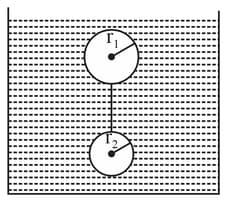Stoke's Law and Terminal Velocity
Stoke's Law and Terminal Velocity: Overview
This topic covers concepts such as Stokes Law, Viscous Force on Spherical Bodies, Velocity of Spherical Ball in Viscous Medium, Terminal Velocity of Spherical Ball, Applications of Stokes Law, Velocity of Rain Drops, etc.
Important Questions on Stoke's Law and Terminal Velocity
A spherical ball of radius and density falls freely under gravity through a distance before entering a tank of water. If after entering the water the velocity of the ball does not change, find . The viscosity of water is .
A parachute descend slowly because it has a large surface area coming down fast so the air which collides with that surface exerts force on that surface in _____ direction so its speed of coming down also gets reduced.
A man descending by parachute does it slowly. Why?
A parachute descend slowly because it has a _____ surface area coming down fast.
With the parachute out it adds more friction slowing him down because air resistance works against the very large surface area of the parachute.
Does a parachute descend slowly?
Millikan's oil drop experiment is used to find:
A copper ball of radius is moving with a uniform velocity in the mustard oil and the dragging force acting on the ball is The dragging force on the copper ball of radius with uniform velocity in the mustard oil is
What will be the approximate terminal velocity of a rain drop of diameter , when density of rain water and the coefficient of viscosity of air ?
Two drops of same radius are falling through air with steady speed v. If the two drops coalesce, what would be the terminal speed.
The terminal velocity of a small steel ball of radius r falling under gravity through a column of a viscous liquid of coefficient of viscosity depends on mass of the ball m, acceleration due to gravity g, coefficient of viscosity and radius r. which of the following relations is dimensionally correct?
In Millikan’s oil drop experiment, an electric field of balances an oil drop of mass . The charge in coulomb on the drop is (assuming )
In Millikan's oil drop experiment, an oil drop of mass is balanced by an electric field of . The charge in coulomb on the drop is (assuming )
When body falls in liquid with terminal velocity, the ratio of resistive force of liquid to its weight is-
The mass of a lead ball is . It falls down in a viscous liquid with terminal velocity . The terminal velocity of another lead ball of mass in the same liquid will be -
Two rain drops reach the earth with their terminal velocities in the ratio . The ratio of their radii is
A small drop of steel falls from rest through a long height in coaltar, the final velocity will be proportional to , then is -
A solid ball of density and radius falls vertically through a liquid of density . Assume that the viscous force acting on the ball is , where is a constant and its velocity. What is the terminal velocity of the ball?
Two solid spherical balls of radius & , of density are tied up with a string and released in a viscous liquid of lesser density and coefficient of viscosity , with the string just taut as shown. The terminal velocity of spheres is-

Two drops of same radius are falling through air with steady speed v. If the two drops coalesce, what would be the terminal speed.
